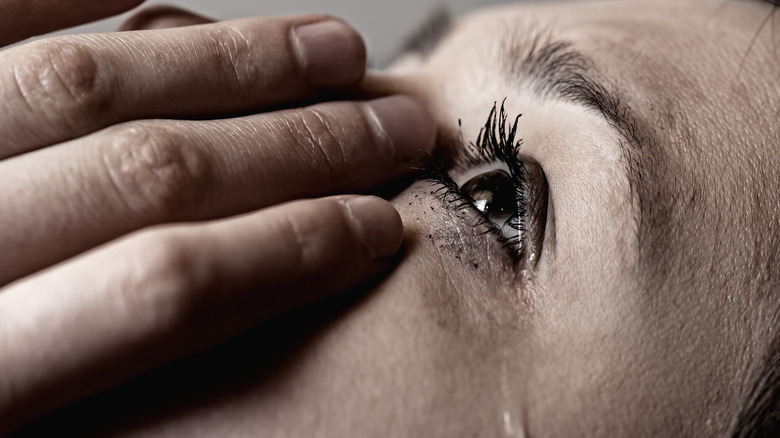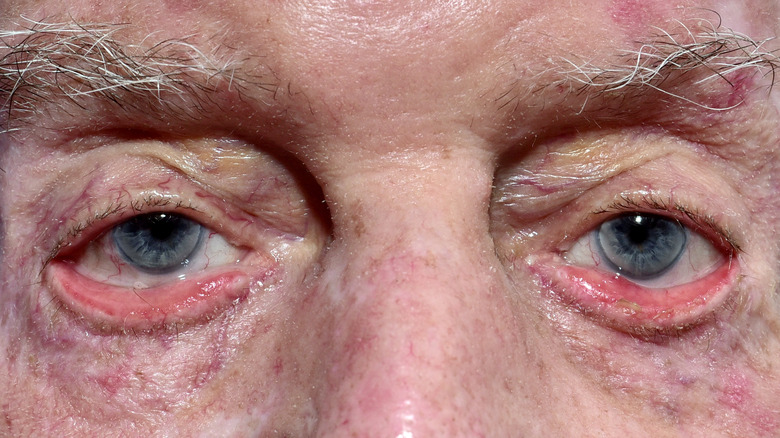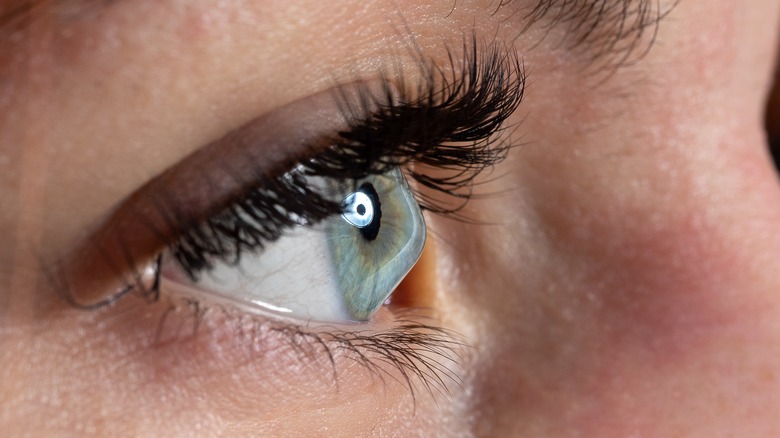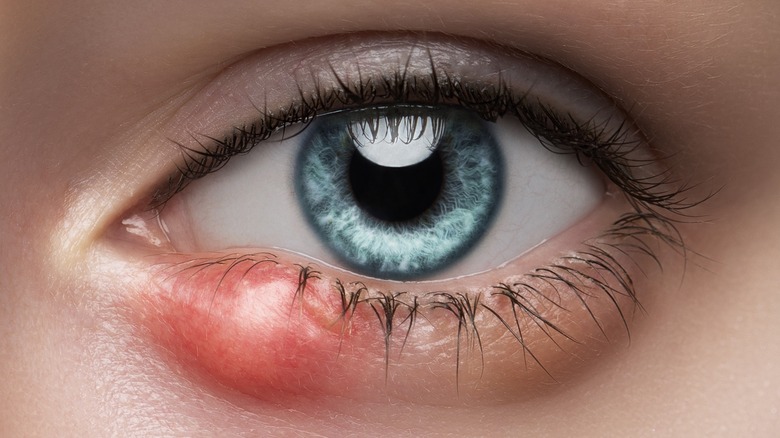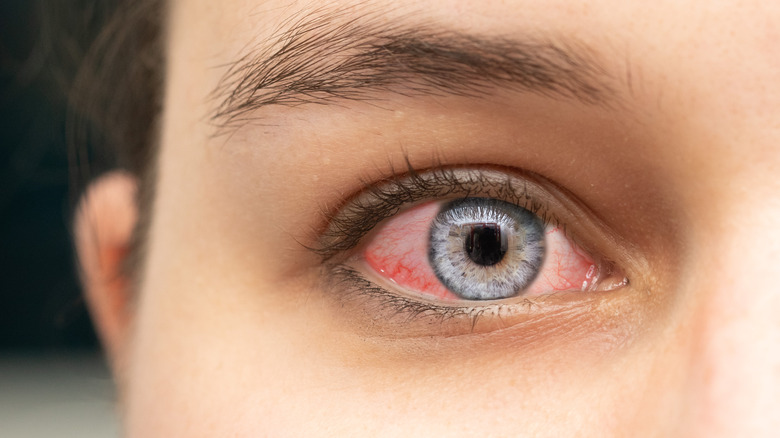What It Means When Your Eyes Water After Lying Down
It's natural to have tears in one's eyes when feeling sad or moved, but even when no tears are running down your face, your body is producing them to keep your eyes lubricated as well as to protect them (via Cleveland Clinic). However, when a person has watery eyes for seemingly no reason (like crying or laughing), that is known as epiphora.
As the Cleveland Clinic explains, epiphora could occur because your body is producing an excessive amount of tears. But even if this isn't the case, it's possible to experience epiphora if the tears aren't properly drained, allowing them to accumulate. In addition, external factors can play a role. According to Vision Boutique, eye strain can be the culprit behind watery eyes. Cedars Sinai notes that using certain electronic devices can result in digital eye strain and one's eyes tearing. So, someone who uses (for instance) an e-reader or a smartphone and then lies down to go to bed could experience digital eye strain-related watery eyes. The Mayo Clinic also states that watery eyes can be a symptom of a dust mite allergy, and that your bedding may actually be housing these pests.
Although there can be simple solutions to watery eyes (such as limiting screen time and replacing bedding), the Vision Boutique also notes that having watery eyes while lying down or otherwise could also be because of health issues. If this is the case, then it's important to seek medical help. Here are some possible causes of watery eyes after you lie down.
Entropion and ectropion
Most of the time, we don't even think about blinking, but as Healthline notes, it serves an important role regarding tears. Each time we blink, our tears are spread out across our eyes, so they are evenly lubricated. For this reason, health conditions that affect our eyelids can lead to watery eyes.
According to the Mayo Clinic, two such conditions are entropion and ectropion. With entropion, typically the lower eyelid becomes turned inward (via Mayo Clinic). This can occur just when blinking or squeezing one's eyes shut, but it can also be the case all the time. Ectropion is the opposite problem, where typically the lower eyelid turns outward (per Mayo Clinic). Just how much of the eyelid is affected by ectropion can vary. Regardless of which of these conditions one has, both can lead to watery eyes. In the case of entropion, the eyelid's skin and eyelashes can rub against the eyeball. As for ectropion, not only is the eyeball more exposed (and so more susceptible to irritation), but the outwardly turned eyelid can also impact proper tear drainage.
While there are products that can help with the symptoms of entropion and ectropion, both conditions typically need to be corrected with surgery. The Mayo Clinic also cautions that both entropion and ectropion can be bad for the cornea, and can be dangerous to one's vision.
Corneal abrasion
According to the Cleveland Clinic, corneal abrasions are a very common reason for someone to have epiphora. The cornea is a clear structure on the front of the eye that is shaped like a dome (per Harvard).
There are a number of everyday activities that can lead to a scratched cornea. For instance, something as small as dust or sand could be enough to cause a corneal abrasion. So, if someone wears contact lenses and isn't careful about cleaning their hands and/or lenses before putting them in, that person could be putting their eyes at risk for a corneal abrasion. Gardening can also lead to corneal abrasion if one performs activities in the garden without wearing protective eyewear. So, too, can playing sports, not only because of airborne debris but also because of contact with another player (e.g., the other player's fingernail could accidentally scratch the cornea).
Besides watery eyes, red flags of a corneal abrasion might include the eye becoming red. The person might also experience a sensation like there's something in the eye. Harvard also states that the vision in the eye might also become blurred, and the person might develop a headache or an abnormal light sensitivity. Even if you're not sure if you or someone else has a corneal abrasion, if you suspect it's a possibility, seek medical help right away.
Blocked tear duct
One might think that having a blocked tear duct wouldn't cause watery eyes. After all, the words "blocked" and "tear" are in the name of this condition. But as the Mayo Clinic explains, tear ducts allow excess tear fluid to drain from the eyes into the nose. And so, a full or partial blockage of these ducts can lead to watery eyes.
A blocked tear duct can cause other symptoms besides watery eyes, including the sclera becoming red, the inside corners of the eye becoming swollen and painful, and one's vision becoming blurred. Someone with a blocked tear duct might have a discharge made of pus or mucus that's from the surface of the affected eye and also from the eyelids. Furthermore, the eyelids can become crusty. An eye infection or eye inflammation can be both symptoms and causes of a blocked tear duct since tears not draining properly can become stagnant and allow fungi, viruses, and bacteria to grow. Other possible causes include facial injuries, a tumor, cancer treatments, and even certain eye drops. However, it's worth noting that skin cells or dirt can be enough to block the tear ducts.
If your watery eyes last for several days, you should seek medical help for a possible tear duct blockage. The Clinic also recommends getting medical help if you have been experiencing an eye infection that won't go away or your eyes keep becoming infected.
Stye
According to the American Academy of Ophthalmology (AAO), a stye (depending on the type) may resemble a pimple that happened to form on your eyelid. Styes are typically small, but despite their size, they may also be the reason behind one's watery eyes.
Styes usually result from a bacterial infection, although one can also develop a stye because of a different medical condition. Another term for a stye is a hordeolum, and a person can have a hordeolum at the base of an eyelash (which is called an external hordeolum) or inside the eyelid (or what's known as an internal hordeolum). In either case, styes are typically red and painful, and while they are also small, they can swell so much that the whole eyelid becomes swollen. Besides a swollen eyelid and watery eyes, styes can also cause sensitivity to light. Other symptoms of a stye can include a sensation like something is in one's eye and/or the affected eye feeling scratchy.
While it might be tempting to squeeze or pop a stye in an attempt to get rid of it, the AAO instructs patients with any kind of stye to not do this in order to avoid spreading the infection. If necessary, a medical professional can drain a stye. Also, the organization instructs against wearing contact lenses or makeup when someone has a stye.
Blepharitis
If you have what looks like crusty dandruff flakes on your eyelashes, that can be a sign of a condition known as blepharitis (via the National Eye Institute). Not only is a possible symptom of blepharitis watery eyes, but blepharitis can also create an ideal environment for styes, which can also cause watery eyes.
Other signs of blepharitis include eyelids that are red and swollen. Additionally, the eyelids typically feel itchy and irritated with this condition. Blepharitis can also make one's eyes red and swollen, as well as itchy, burning, and/or stinging. Sensitivity to light is also common, as is one's tears containing bubbles or becoming foamy. Patients with blepharitis can experience health issues like their eyelashes falling out and/or growing in incorrectly. What's more, blepharitis can affect the cornea. Blurry vision is another possible blepharitis-related medical problem.
While an excess of bacteria on the eyelids is a common cause of blepharitis, it can also occur if your eyelids' oil glands become irritated or clogged. And although it's rare, mites and allergies can also be the culprits behind a case of blepharitis. It's worth noting that health concerns like rosacea, oily skin, and dandruff can increase the chances of developing blepharitis. And while you should speak with a medical professional if you think you have blepharitis, carefully cleaning one's eyelids daily can help treat it.
Dry eye disease
Dry eye disease might sound like the least likely health problem to cause watery eyes. However, as the Mayo Clinic explains, not only are watery eyes possible with dry eye disease, it's one of this condition's potential symptoms.
Lower-than-normal tear production is just one possible cause of dry eye disease, though. It can also happen if your body makes what the Clinic refers to as "poor-quality tears." Like the ingredients in a recipe, your tears have a certain formula, and when that formula is off, the tears can't do their job properly (i.e., protecting and soothing your eyes), per Florida Eye Specialists. What can follow is a domino effect where the eyes can become inflamed, which can lead to the body producing more incorrectly formulated tears, which can increase the chances of you rubbing your eyes, which can irritate them further.
In addition to causing watery eyes, dry eye disease can also make one's eyes red, as well as scratchy, stingy, or burning (via Mayo Clinic). A patient with dry eye might also feel as if something is in the eye, as well as experience eye fatigue and/or blurred vision. Stringy mucus might also occur because of dry eye disease, specifically either around or in the eyes. And activities like driving at night and wearing contact lenses can be more challenging if you have dry eye. Furthermore, dry eye can result in other medical problems, like eye infections.
Conjunctivitis
If you've ever seen a case of conjunctivitis, you understand why it's also known as pink eye since it makes the sclera of one's eye pink or red, via CDC. But besides changing the appearance of your eyes, the CDC explains that conjunctivitis can cause your body to produce more tears than normal.
Now, you might have heard that pink eye is the result of either viruses or bacteria, but as the CDC points out, these are just two of the possible causes behind a case of conjunctivitis. Parasites, fungi, and ameba can also cause pink eye. So too can allergens, chemicals, and air pollution. Even something as simple as a loose eyelash being in one's eye could be the reason for pink eye. And for contact lens wearers, not cleaning your lenses correctly and/or keeping them in your eyes for too long could result in conjunctivitis. In fact, if your contact lenses move around instead of staying in place, that could be a red flag of pink eye. Other signs of conjunctivitis can include burning, irritated, or itchy eyes.
Of course, if you think you or someone else has pink eye, contact a health care professional especially if you're experiencing other problems like extremely red eyes, eye pain, blurry vision, and/or sensitivity to light, per CDC. And let a medical professional know if you've been using antibiotics for 24 hours to treat conjunctivitis diagnosed as bacterial in origin but are experiencing either no improvement or worsening symptoms.
